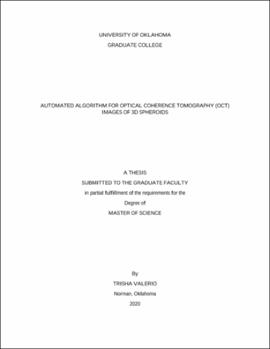| dc.contributor.advisor | Tang, Qinggong | |
| dc.contributor.author | Valerio, Trisha | |
| dc.date.accessioned | 2020-12-22T17:38:08Z | |
| dc.date.available | 2020-12-22T17:38:08Z | |
| dc.date.issued | 2020-12-18 | |
| dc.identifier.uri | https://hdl.handle.net/11244/326681 | |
| dc.description.abstract | The application of three-dimensional (3D) tumor spheroids has been expanding due to their ability to closely mimic several features of solid tumors such as their cellular heterogeneity/organization and growth kinetics. Optical Coherence Tomography (OCT) system has been utilized to characterize 3D morphological and physiological information of multicellular tumor spheroids. In order to characterize and analyze the results of 3D OCT spheroid datasets, there is a need to develop an automated algorithm with high accuracy that can calculate the volume of a tumor spheroid and its necrotic tissues. The developed automated algorithm can automatically detect the margin of the 3D tumor spheroids and its necrotic region. The measurements from the automated program were then compared with the manual method to assess the accuracy of the developed algorithm through calculations of the Dice coefficient, and the results show a Dice number of 0.9449 and 0.9145 for spheroid and necrotic volume algorithms, respectively. Additionally, curve fitting was performed to further study the growth kinetics of the spheroid and its necrotic tissues, and measures such as root-mean-square error (RMSE) and corrected Akaike information criterion (AICc) were taken for this assessment. According to the RMSE measure, Boltzmann was the best-fitted model for the overall spheroid volume growth. The logistic model, on the other hand, was best fitted in modeling the growth of necrotic core according to both RMSE and AICc values. Quantification of the spheroid volume (and its necrotic core) is significant as morphological features are often related to tumor activities, and determination of the best model is also vital in predicting the behavior of the spheroids. Overall, the algorithm used for this study allows for more efficient, in both time and accuracy, studies such as evaluating the growth medium’s effect on tumor spheroids, growth characterization of varying cell lines, as well as the efficacy of a certain drug. | en_US |
| dc.language | en_US | en_US |
| dc.rights | Attribution-NonCommercial-ShareAlike 4.0 International | * |
| dc.rights.uri | https://creativecommons.org/licenses/by-nc-sa/4.0/ | * |
| dc.subject | Optical Coherence Tomography | en_US |
| dc.subject | Tumor Spheroids | en_US |
| dc.subject | Growth Modeling | en_US |
| dc.subject | Optical Imaging | en_US |
| dc.title | Automated Algorithm for Optical Coherence Tomography (OCT) Images of 3D Spheroids | en_US |
| dc.contributor.committeeMember | Acar, Handan | |
| dc.contributor.committeeMember | Yuan, Han | |
| dc.date.manuscript | 2020-12-18 | |
| dc.thesis.degree | Master of Science | en_US |
| ou.group | Gallogly College of Engineering::Stephenson School of Biomedical Engineering | en_US |
| shareok.nativefileaccess | restricted | en_US |

